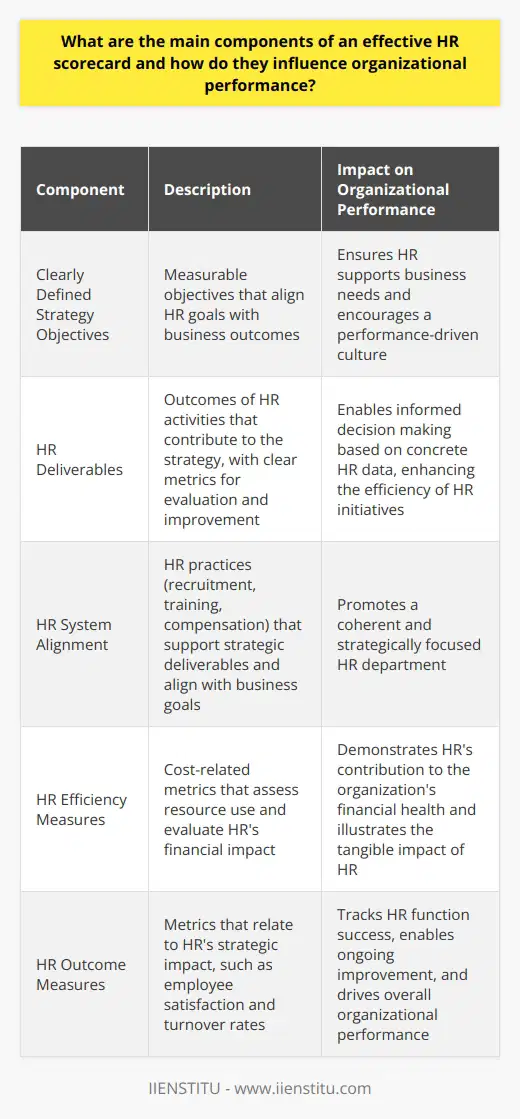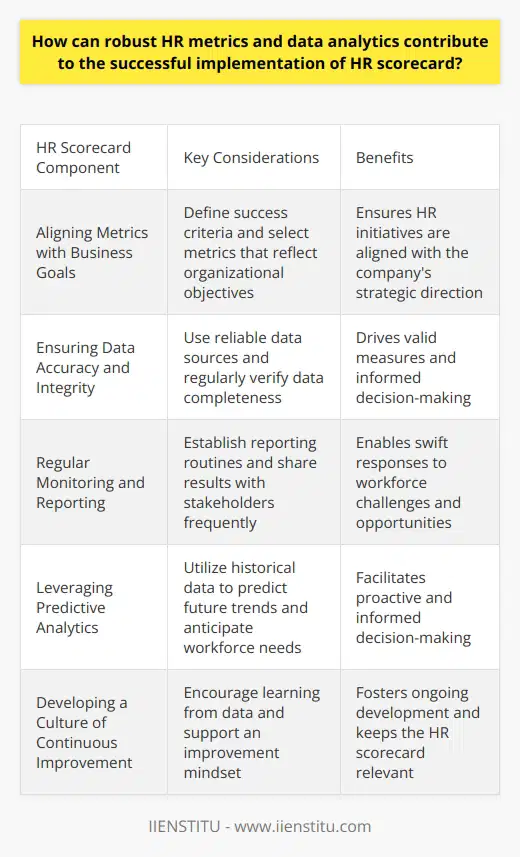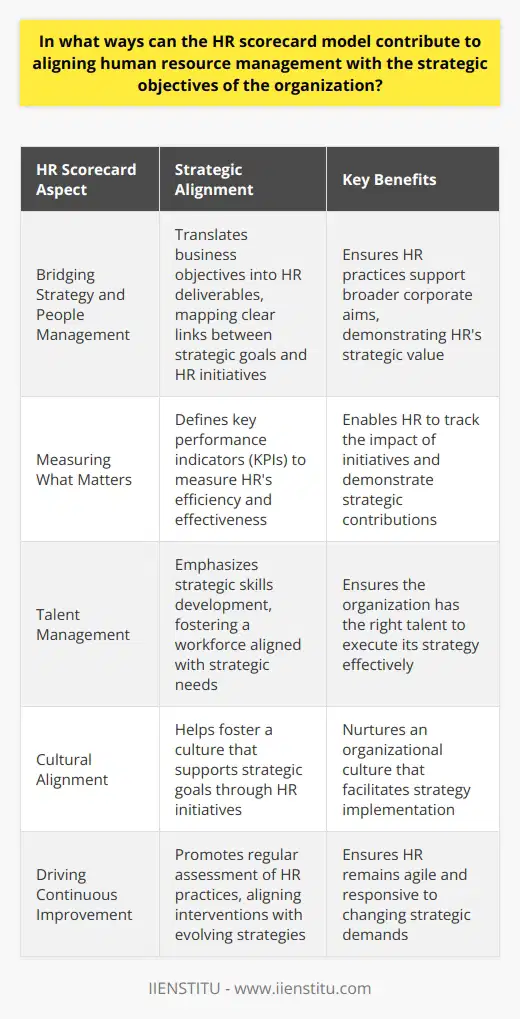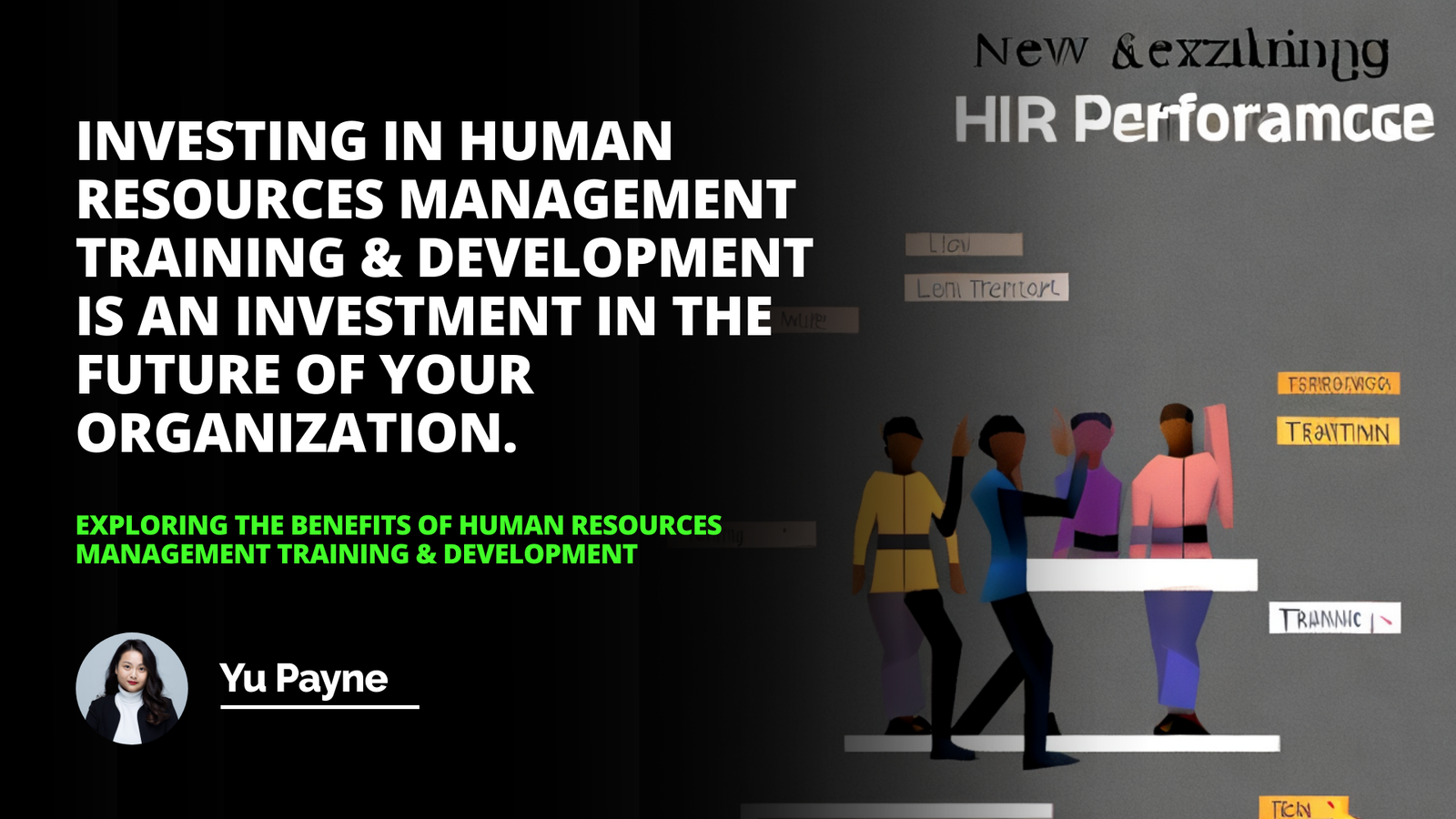
In an increasingly competitive business landscape, the role of Human Resources (HR) continues to evolve, with a growing emphasis on strategic alignment and performance measurement. The HR Scorecard is a vital tool that has emerged to tackle this need, enabling organizations to seamlessly connect HR activities with broader business objectives.
Through a robust framework, HR Scorecards facilitate a comprehensive understanding of HR's impact on organizational success. In this article, we will explore the concept of the HR Scorecard, delving into its purpose, design, benefits, and strategies for overcoming implementation challenges. This discussion will be invaluable to both seasoned HR professionals seeking to enhance their strategic input and to those interested in professional development through hr training and certificate courses online.
Introduction
The HR Scorecard is a performance measurement framework that translates an organization's strategic goals into HR deliverables. Emerging from the need to demonstrate HR's contribution to business outcomes, the HR Scorecard enables organizations to quantify the impact of human capital investments and HR initiatives.
Definition of HR Scorecard
The HR Scorecard is a customized toolkit designed to measure and aid the strategic impact of HR functions. Unlike traditional measurement systems which often track operational metrics, the HR Scorecard focuses on strategic objectives that pertain to long-term organizational success.
Brief background on the development and importance of HR Scorecards
The concept of the HR Scorecard was introduced by academics like Dave Ulrich, aligning with the balanced scorecard framework developed by Kaplan and Norton. Its importance is rooted in the necessity for HR to move beyond administrative functions and contribute to strategic decision-making.
Purpose of HR Scorecards in Management
For a business to thrive, it must ensure that its HR strategies are aligned with its corporate vision and objectives. The HR Scorecard acts as a compass to navigate the complex territory where human capital and business strategy converge.
Empowering Employees: The Role of Corporate HR as an Advocate
HR Employee Turnover Analysis: Key Strategies and Implications
Understanding the alignment of HR practices and corporate strategy with HR Scorecards
An HR Scorecard effectively details how HR practices promote and support a company's strategic aims. It establishes a clear linkage between workforce initiatives and their resultant impact on organizational performance.
Role of HR Scorecards in decision making and resource allocation
By assessing HR contributions through carefully chosen metrics, leadership can make enlightened decisions about allocating resources and shaping policies to advance their strategic agenda.
Designing an HR Scorecard
The creation of an effective HR Scorecard is a multi-stage process that demands a thorough exploration of the organization's strategic framework as well as a profound understanding of its human capital dynamics.
Step-by-step process in creating an HR Scorecard
Identifying strategic objectives
The primary step in crafting an HR Scorecard is to identify the organization's strategic objectives. These objectives should serve as the foundation upon which the HR Scorecard is built.
Defining key performance indicators (KPIs)
Subsequent to establishing strategic objectives, HR departments must define relevant KPIs that will be used to gauge performance in relation to those objectives.
Measurement and data collection
With KPIs identified, the next step involves developing a systematic approach to measurement and data collection, ensuring that the information acquired is both accurate and actionable.
Scorecard customization and design
Finally, the HR Scorecard must be tailored to fit the unique cultural and operational nuances of the organization to maximize its effectiveness and relevance.
Considerations in designing effective HR Scorecards
Aligning HR objectives with organizational goals
The HR Scorecard must reflect a true alignment of HR objectives with overarching business goals, confirming HR's strategic role.
Ensuring measurability and relevance of defined KPIs
KPIs should be carefully crafted to be measurable and directly relevant to both HR and business success.
Managing and integrating collected data
Effective data management and integration are paramount to ensure that insights drawn from the HR Scorecard are accurate and can influence meaningful change.
Periodic reviews and necessary adjustments
As with any strategic tool, the HR Scorecard should undergo regular reviews and necessary adjustments to remain current with changing business landscapes.
Illustrative examples of a well-designed HR Scorecards
For instance, a well-designed HR Scorecard might track the influence of a new leadership development program on revenue growth, attributing increments in customer satisfaction and sales directly to improved managerial competencies.
Benefits of Implementing HR Scorecards
The introduction of the HR Scorecard into an organization offers a spectrum of advantages that enhance the business's strategic posture and HR's prominence in contributing to success.
Enhancing strategic alignment and focus
An HR Scorecard ensures that every HR initiative launched is meticulously aligned with the business's strategic focus, avoiding misallocation of resources and efforts.
Improved decision making and performance tracking
Analytics derived from the HR Scorecard empowers leaders with evidence-based insights to shape informed decisions in both the short and long term.
Driving strategic HR initiatives and fostering an engaged workforce
The HR Scorecard is a potent catalyst for strategic HR initiatives that foster an engaged and high-performing workforce, capable of propelling the organization to new heights.
Examples of successful implementation of HR scorecards and their impact
Businesses that have successfully incorporated HR Scorecards can attest to their transformative effect, from refined talent acquisition strategies to heightened employee productivity and morale.
Overcoming challenges in HR Scorecard implementation
The implementation of an HR Scorecard, while beneficial, is not without its hurdles. Addressing these effectively is essential for the success of the Scorecard as a strategic tool.
Dealing with lack of data or data inaccessibility
Organizations may encounter challenges such as data paucity or inaccessibility, which can impede the utility of the HR Scorecard. Tackling these requires a proactive approach to data governance and infrastructure.
Training and enabling HR personnel to use the Scorecard
HR training is vital to equip HR personnel with the skills necessary to effectively utilize the Scorecard and interpret its findings.
Addressing resistance to change and fostering adoption
Resistance to change can often slow down the adoption of new practices like the HR Scorecard, but this can be overcome through clear communication and change management strategies.
Examples of overcoming challenges in HR Scorecard implementation
Instances where companies have overcome such obstacles typically involve executive sponsorship, continuous education, and the demonstration of early wins to build momentum.
Conclusion
The HR Scorecard remains a key instrument for businesses aiming to marry HR performance with strategic business objectives. Its importance cannot be overstated, given the increasing demands placed upon HR to justify its strategic value.
Frequently Asked Questions
What are the main components of an effective HR scorecard and how do they influence organizational performance?
Understanding the HR Scorecard
The HR scorecard serves as a strategic tool. It aligns human resource policies with overall organizational strategies. This tool measures HR function's effectiveness. It transforms abstract human capital into concrete strategic outcomes. Successful HR scorecards encompass several main components. Each influences the organization uniquely.
The Key Components
Clearly Defined Strategy Objectives
Strategy objectives form the scorecard's backbone. They provide direct links to business outcomes. Objectives must stand clear and measurable. HR aligns its goals with these strategically.
HR Deliverables
HR deliverables represent the outcomes of HR activities. They contribute directly to the strategy. Each deliverable should have clear metrics. Metrics allow for evaluation and improvement.
HR System Alignment
System alignment concerns HR practices. These practices must support strategic deliverables. Recruitment, training, and compensation fall into this category. All must align coherently with business goals.
HR Efficiency Measures
Efficiency measures assess resource use. They answer "How well are we using our resources?". These are cost-related metrics. They are crucial for evaluating HR financial impact.
HR Outcome Measures
Outcome measures relate to HR's strategic impact. They determine the achievement of HR's strategic goals. They often include employee satisfaction and turnover rates.
The Influence on Organizational Performance
Strategic Alignment
Strategic alignment ensures HR supports business needs. It bridges the gap between HR activities and strategic goals. It encourages a performance-driven culture.
Decision Making
Accurate metrics guide informed decision making. Leaders base decisions on concrete HR data. This enhances the efficiency of HR initiatives.
Accountability
Clear metrics induce accountability. They allow for performance tracking. Accountability in HR activities ensures objectives remain in focus.
Performance Evaluation
Evaluation measures track HR function success. They enable ongoing improvement. Performance-focused HR drives overall organizational success.
Communication
Effective scorecards promote transparency. They communicate HR's value and progress. Communication facilitates understanding across the organization.
Financial Impact
Efficiency in HR translates to cost savings. It shows HR's contribution to the organization's financial health. Financial metrics illustrate the tangible impact of HR.
In conclusion, an effective HR scorecard features components critical to weaving HR strategy with business objectives. It turns HR into a strategic partner. It showcases HR's role in driving organizational performance. Implementing these components fosters a culture of accountability and continuous improvement. An organization benefits from a focused and strategically aligned HR department.

How can robust HR metrics and data analytics contribute to the successful implementation of HR scorecard?
Understanding HR Scorecard
The HR scorecard is a strategic tool. It links human resources to a company's goals. It measures how HR contributes to success. The scorecard tracks key metrics. These metrics align with business strategy.
Importance of HR Metrics and Data Analytics
HR metrics measure HR performance. Data analytics interprets these metrics. Together, they offer insights. These insights drive strategic decisions. They tackle workforce challenges.
Robust HR Metrics
Quantifiable measures are key. They reflect HR effectiveness. Robust metrics show the value of HR. They guide improvements.
Data Analytics in HR
Data analytics turn metrics into intelligence. They reveal patterns. They predict outcomes. This helps adjust HR strategies.
Implementing an Effective HR Scorecard
Aligning Metrics with Business Goals
Start with the end in mind. Define what success looks like. Choose metrics that reflect these goals. They must mirror organizational objectives.
Ensuring Data Accuracy and Integrity
Use reliable data sources. Verify data regularly. Ensure data completeness. Accuracy drives valid measures.
Regular Monitoring and Reporting
Create reporting routines. Track metrics often. Share results with stakeholders. Swift responses depend on regular updates.
Leveraging Predictive Analytics
Use historical data. Predict future trends. Make informed decisions. Anticipate workforce needs.
Making Data-Driven Decisions
Rely on data analysis. Make objective decisions. Avoid baselines without evidence. Drive change with facts.
Closing the Feedback Loop
Gather feedback after decisions. Understand impacts on metrics. Adjust strategies as needed. Use feedback to refine.
Developing a Culture of Continuous Improvement
Encourage learning from data. Support an improvement mindset. This keeps the HR scorecard relevant. It fosters ongoing development.
Conclusion
HR metrics and data analytics are crucial. They ensure a successful HR scorecard implementation. They lead to informed and strategic decision-making. They promote a data-driven culture. They transform HR into a strategic partner.

In what ways can the HR scorecard model contribute to aligning human resource management with the strategic objectives of the organization?
The HR Scorecard's Strategic Role
Human Resource Management (HR) plays a crucial role in executing a company's strategy. The HR scorecard model emerges as a strategic partner. It aligns HR with organizational goals.
Bridging Strategy and People Management
The HR scorecard translates business objectives into HR deliverables. It maps out the clear links between strategic goals and HR initiatives. This alignment ensures that HR practices support broader corporate aims.
Measuring What Matters
Metrics are vital. The HR scorecard involves defining key performance indicators (KPIs). These KPIs measure HR's efficiency. They track the effectiveness of HR initiatives. Such metrics enable HR to demonstrate its strategic value.
Defining Clear Objectives
The model prompts HR to set clear targets. These reflect strategic business aims. Clear objectives guide HR activities. They make HR's impact on strategy visible.
- Strategy Execution
The HR scorecard turns strategy into executable tasks. HR policies and practices align with these tasks. The alignment ensures that HR actively contributes to strategy execution.
- Talent Management
Talent is crucial for strategic success. The HR scorecard emphasizes strategic skills development. It fosters a workforce aligned with strategic needs.
- Cultural Alignment
Company culture affects strategy implementation. The HR scorecard helps foster a culture that supports strategic goals. It ensures HR initiatives nurture the right organizational culture.
- Change Management
Strategies often invoke change. The HR scorecard equips HR to manage change effectively. It does so by linking change management practices with strategic needs.
Enhancing Accountability
The HR scorecard enhances HR's accountability. It does this through quantifiable outcomes. HR can thus clearly articulate its contributions to strategic goals.
Driving Continuous Improvement
This model promotes regular assessment of HR practices. Continuous improvement becomes a norm. HR interventions always align with evolving strategies.
Fostering Strategic Competence
HR becomes a strategic player. It uses the HR scorecard to develop competencies that serve strategic aims. HR professionals, therefore, become strategic partners.
Conclusion
The HR scorecard stands as a pivotal tool for weaving HR into the strategy fabric of an organization. It ensures that HR not only supports but also drives the achievement of strategic objectives. HR ceases to be a mere back-office function. It becomes a core lever for strategic success.



